
Meat Target
-
Posts
57 -
Joined
-
Last visited
Content Type
Forums
Profiles
Events
Store
Posts posted by Meat Target
-
-
Great information, thanks!
Question, on the Rolling Thunder, did you tune it in any way? Benny's instructions are to have a side hole drilled (right side if you are right handed) and shot/tuned until it sits flat as you shoot it. If that didn't happen, I'm sure the simulation will not account for it and will skew the outcome. I know there is a variance there but it really makes a big difference with that comp and having it tuned.
Any way, great work and thanks for sharing with the community!
Tuning the comp by adding a side hole or opening up the top one wouldn't change the total amount of overall recoil reduction much, its more to adjust for individual variations in gun dynamics and how each person holds the rifle. I could add in the hole tuning changes to the simulation and get an idea of what the changes will do but it wouldn't tell you if would work better.
The simulations are good for giving an idea on how effective the comps are in using the gas energy available but they can't tell you the last little tweaks needed to dial it in for each individual person.
-
That's the old "Master Blaster" that brownells used to sell. Only the MB had 3 ports and came in two sizes.
I still have one and they are very effective and loud.
Nick
It may look like it by coincidence, do you have a picture of it? I would be interested to see the port design on it.
-
Just got back from testing out the new comp, works very well. I was hitting off-hand double taps (0.16 - 0.18sec splits) on a 100yard full size steel IPSC target using a 4x scope, cross hairs never left the target (with low mass carrier/buffer and adj. gas block). Back blast towards the shooter is a non issue, I had someone else shoot it and they didn't notice any either. While they were shooting I was standing off to side and didn't notice any excessive noise or blast. Its definitely quieter than the Miculek comp, the bigger ports did help with the noise.
I was going to run a comparison with the other comps but it was only 9F out and my fingers were going numb, so I wussed out and decided to hold off on that until it warms up a little. If I really want to "Nerd it out" I could thrown some accelerometers on the rifle and calculate the actual barrel movement with different people shooting the various comps, but I think I already may have my plate full with other projects for this year.
Looks like there may be something to this computer simulation stuff after all. For now I am completely happy with the performance of the comp and can't think of anything that I would change other than possibly making a lighter version of it, of course my opinion may change once I start trying out some of the other comps out there and find one that works better.
-
Could You make similar simulation from JP Tank?
That's another comp that I would like run a sim on. My initial impression just by looking at it is that it should work very well, but its way bigger than it needs to be. I know someone that has one that I could borrow to get the measurements off of. Maybe in a month or so I could have something to share on it.
Simulations are a good start, but they still have some error and don't tell the whole story. But dang, 24 hours! I thought mine was long at 18 hours, but only had to run one simulation.
Yep it just a start, but that why I used the other comps as a baseline so I could narrow down the trial and error part when actually making them. I had the simulation mesh count up to about 700k cells on the final few runs that why it took so long to complete.
-
Not a nerd here (too dumb and simple) but just looking at this brake makes me think of it being kind of concussive to the shooter. In the pursuit of removing rearward recoil, it looks like it would direct a lot of gas back to the shooter. Haven't tried the SJC Titan yet but this is what I've heard as one of the major complaints. Your design does look very effective for such compact dimensions.
The blow back towards the shooter is not as bad as you would think just by looking at it. I have a larger version with about the same baffle angles and you do not notice any blow back at all. Also because of the larger ports the side blast pressures will be a lot lower than the Titan's.
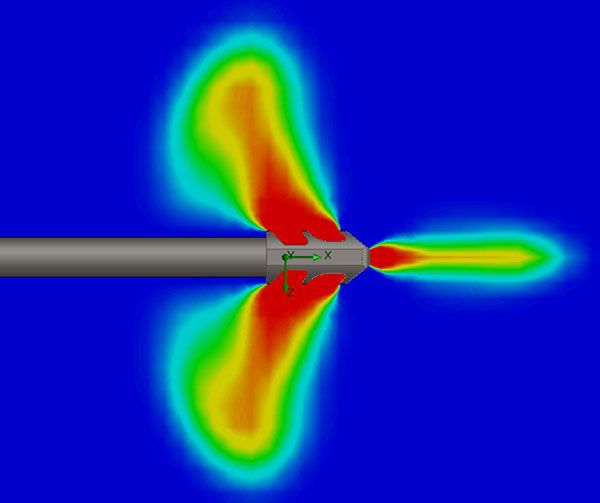
From this picture you can see that the gas flow moves back towards the shooter a few inches but then start moving out to the sides. I will find out for sure tomorrow when I try it out.
-
Interesting looking design.
If we are nerding out here, could you summarize how you modeled the gas dynamics of the problem? Did you use a stock industry standard CFD code or a different simulation technique? I'm very curious because it seems like a very difficult fluids problem. I have a bad enough time simulating rocket plumes and wouldn't touch this problem with a ten foot pole!
Thanks.
Solidworks Flow simulation solver uses Favre-averaged Navier-Stokes equations with transport equations for the turbulent kinetic energy and dissipation rates. The initial conditions for barrel pressures were obtained from QuickLoad software, propellent gas properties were obtained from military research documents on rifle muzzle blasts for temperatures and ratio of specific heat.
If you look at some of my other posts I have links for videos of the simulations I have done on the other compensator if you are interested.
-
Just finished up my new rifle compensator this week. Ran over 50 different combination through Solidworks to come up the design. The last few runs took my computer over 24 hours to finish crunching the numbers.
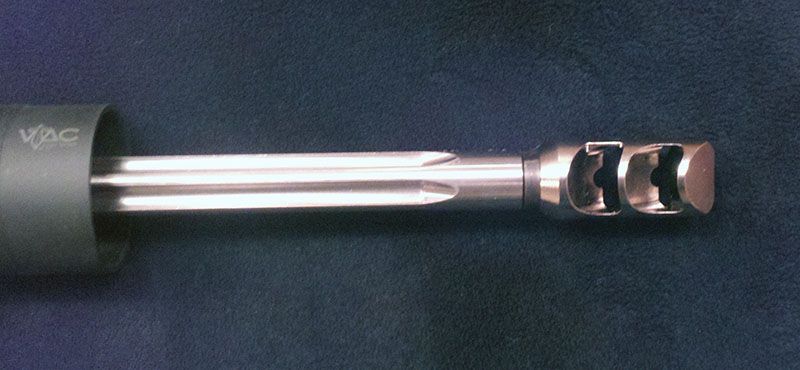
With the new trend in 3-gun going toward short and lighter barrels the goal was to make the compensator as small and light as possible but still be effective. My target was to be as good or better than the SJC Titan for recoil reduction and lighter than the Miculek comp. For down force I didn't want to put too much in, so I designed it to be in the middle of the pack when compared to the others.

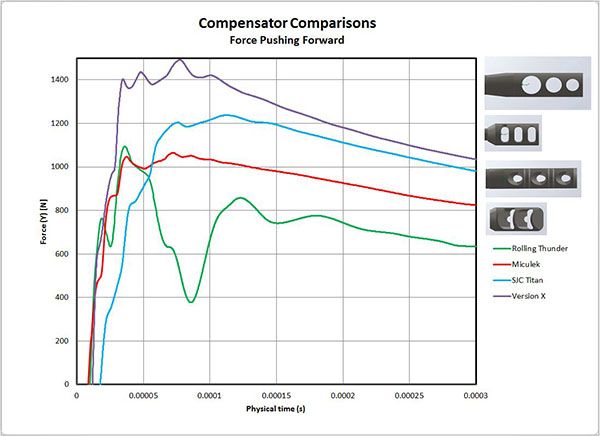
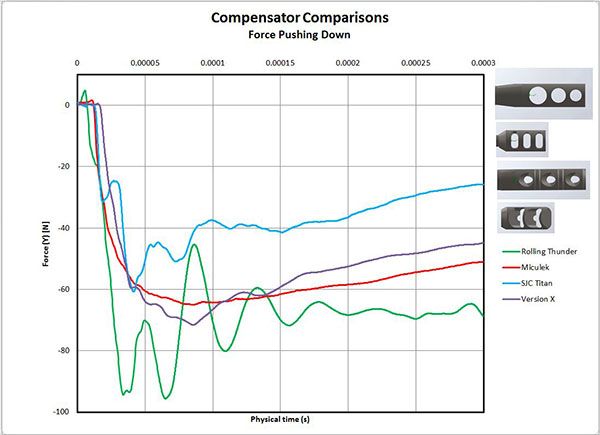
My last comp weighed in at 4.5oz its amazing how much lighter the gun feels just by dropping almost 2 oz off the front end. I am thinking about going from an 18" to a 16" barrel just to drop a few more ounces off.
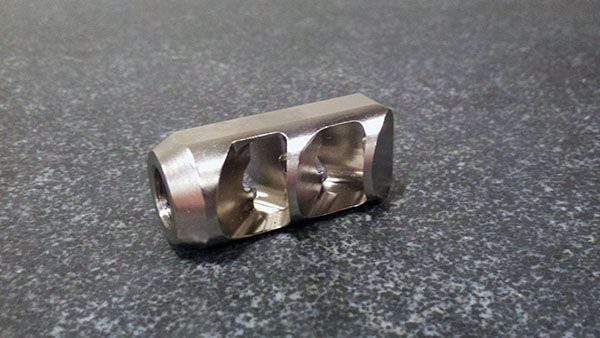
Its made out of case hardened 1018 low carbon steel with a 1mil of cobalt plating. I ran an FEA on the part using the forces from the simulation to make sure the design was strong enough. I would love to make one out of titanium but the machining of it would be tough going without a CNC machine. The angles are a little more complex than they look in the picture and the set up takes a long time using a manual mill.
The side ports are fairly large so it shouldn't be too loud. I played around with the baffle angles to try and keep down the back blast towards the shooter, it looked good on the simulations I will find out quick enough. I have a shotgun comp that I built last year that works great but blows your hair back every time you pull the trigger, looks like something Flash Gordon would have on the end of his ray gun.
I am hoping to try it out this weekend. If its not too cold out (18 F here in Michigan) I would like to throw on the other comps to run a comparison.
-
The Titan does have the lowest down force but that doesn't necessarily mean that it needs more of it, it could work perfectly the way it is depending on your setup.
But if you feel like you need more down force the first thing I would try is to open the fist hole (closest to the muzzle) a little. I wouldn't make the hole bigger than the hole its connecting into, so around 0.25" max. Opening up the second hole won't do much.
Then if you really want to increase it some more, you could add a small hole in the location marked in red, and work the hole size up from there. Just be careful and check twice before drilling, the picture does not show the gap between the muzzle and the compensator so you don't have as much room to work with as it looks.
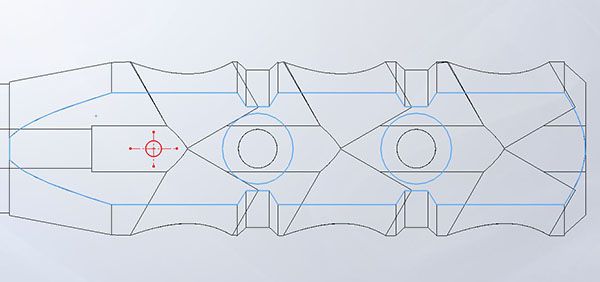
-
Here is another simulation I just finished on the SJC Titan compensator, a big thanks to waktasz for sending one out to me.
I was kind of surprised in that the port design was a lot more complex than I was expecting. As you can see in the graph below it has the best simulated recoil reduction so far, but it also has the lowest down force. Because of its smaller port design the last port actually gets some use.
From talking to people that use this comp the consensus is that it works great but is extremely loud. You also need to keep up on the cleaning because it builds up carbon deposits very quickly and starts to effect accuracy, one person actually started to get their bullets tumbling.
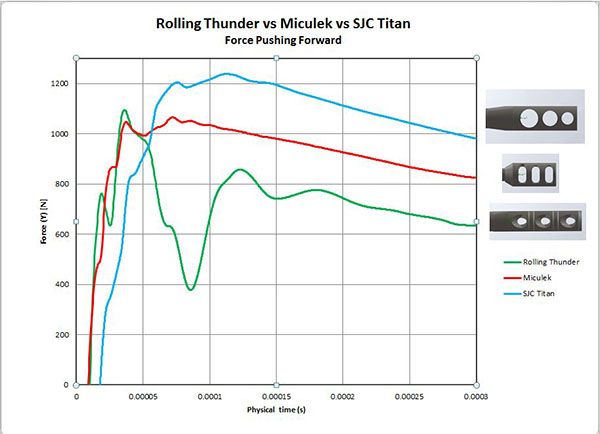
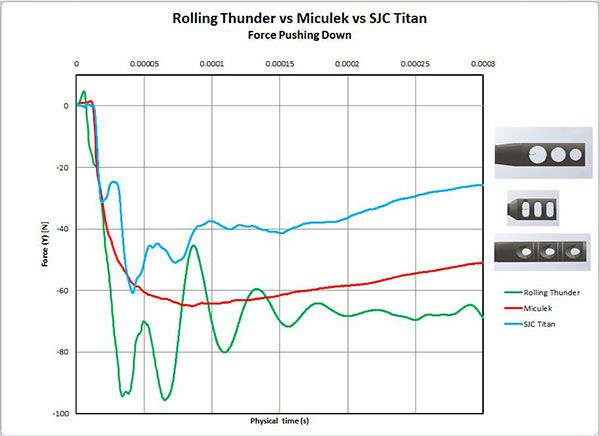
-
Just notice I posted the wrong table, its missing some of the powders. Here is the correct one. (pass the 2 day edit window...)
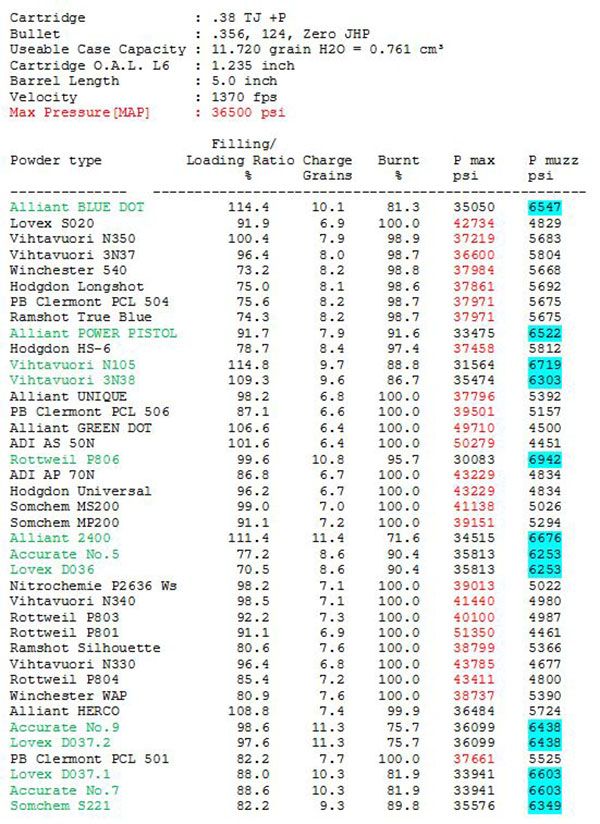
-
Thanks! Do you have the numbers for Ramshot Silhouette?
one powder not on that list that is very popular (certainly here in aus) for major loads is ADI AP100. Not sure why it wasn't on either list, but it's probably sold in the US under another brand.
Sorry about that, here is another run will all of the powders in the database that would calculate. Sihouette and AP100 are included. I had the burn rate range limited in the making of the table so a bunch of powders were skipped. So in this list most of the powders could not actually be used. ie. 225% filling ratio.
-
Meat Target,
Can you do a Quickload run with the same parameters and powders only with a 115 gr bullet?
Thanks;)
Here you go, sorry if its a little hard to read. I did attach a higher resolution copy as a file.
Just remember these are just approximations, check published reloading data.
SAAMI Pmax (MAP) for 38 super +p is 36500 psi.
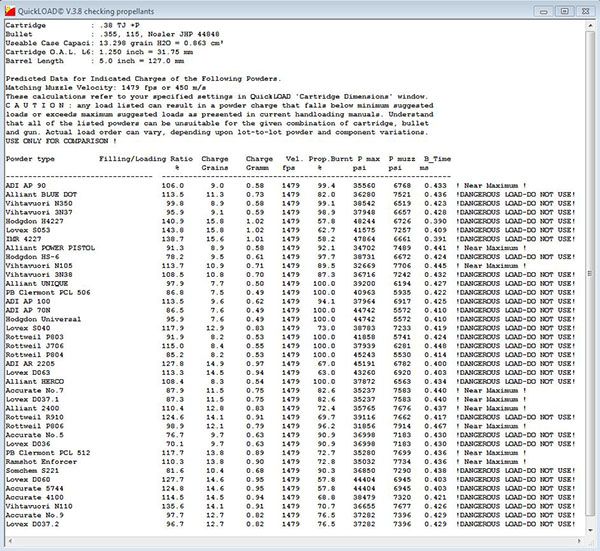
-
Dammit I've been working on a reverse rolling thunder design and now you have ruined it. I already have a cleaver name too. The Thunder Rolls Comp.
I too would like to see the Seekins ATC. I'm luvin' it!
If someone has a good CAD model of the ATC they would send me I could do a run on it. Another popular comp that I would like to do a simulation on sometime is the SJC Titan.
Kind of hard to justify dropping the money on them just to get some measurements.
-
Here is something interesting that I had a feeling about when I first saw the Rolling Thunder comp. If you flip the hole pattern around it should work a little better for recoil reduction.
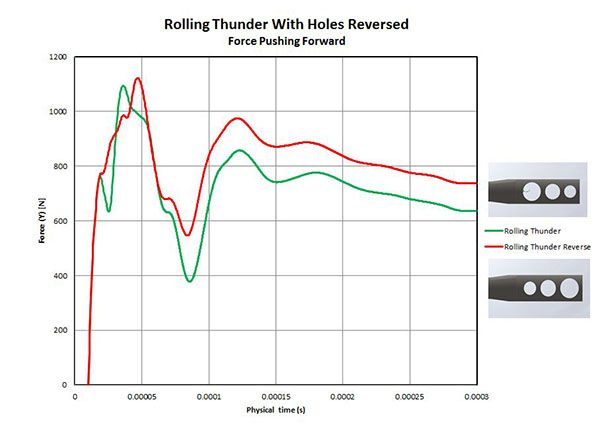
-
All this modeling seems to be taking the discarge as a gas, while I think it is more like a plasma. The "gas" collum is carrying alot more than just hot air, copper and lead vapor, carbon etc. Gas modeling is good for a comparison, but I don't think it tells the real story. BTW Mark is right about the quentch area...but it is a small price to pay. Just take it off occasionally and clean the crown. All compairison modeling is great, but it is how the comp interfaces with the rest of the package as to how effective it is, meaning rifle and rifle holder. I have shot a bunch of comps and what feels great on one rifle will not be good on another. Internal ballistics of the barrel and gas system effect each comp differently and each barrel/gas system is different. Think finger prints and snow flakes! And dare I say that is why there are a whole bunch of comps on the market.
Some of you have seen my new comp and know how much "math" time I spent on it, but the final design still had some tweaks that were derived from experience and understanding of the system and the interactions of the variables. For those of you without an engineering background, any good, and honest, engineer will tell you that the models and the computer programs produce "approximations" based on multiple assumptions and that is why you don't go make anything based off a math model...or why that bridge has a factor of safety of like 3x. So don't get too twisted up in models, performance in the hands is what really matters.
I totally agree with both of you in that there are a lot of other factors involved that can't be simulated on the computer. Simulations are just another tool to play with, at least it can give you an idea of what going on and may help out in the design process. But Its a lot better than guessing and randomly drilling holes into a chunk of metal.
I do have a design that shows a 25% improvement in recoil reduction over the Miculek comp but that doesn't mean that it will work better in the end. In reality with the AR platform once you get to certain amount of recoil reduction the bolt cycling will have a bigger influence on barrel movement. It could be that the weight of the compensator and balance of the rifle will have a bigger influence over the amount of recoil reduction.
Just sharing some work I have done, not trying to sell anyone on it.
-
Meat Target, I was wondering if there is an error in creating the down force chart above, since in the video of the miculek comp the down force varies from -50 to -85 N, but in the chart above, only -50 to -65. If plotted according to the video's chart both comps would be about the same, with a smoother force contour from the miculek. JMTC
Nice catch, but you missed my disclaimer " *Note: The forces shown in the Miculek video are a little higher than shown in the comparison graph. The comparison graph results were calculated at a higher resolution and are more accurate."
One more thing, looks like the rolling thunders last baffle is not used, while the Miculek's still contributed about 15% of the total force pushing forward. Maybe a shorter RT with only two baffles may help making it lighter
If the compensator is designed well two ports is all you realy need. The Mickulek comp's ports are a lot smaller so a bunch of gas makes it to the third port.
-

I assume your modeling does not account for adiabatic expansion? When you toss that in, the numbers change, but the comparisons are still valid between the two. Pretty easy to see why the RT fouls the muzzle so bad as your model is pretty close in showing that the quenching temperature occurs back at the muzzle face due to the expansion chamber.
The simulation was run using propellant gas temperature and ratio of specific heats obtained from military research documents on the CFD analysis of rifle muzzle blasts. That’s the best information on the properties of propellant gases I have found so far. But it did not calculate heat transferred into the muzzle brake as it had very little effect on the results.
Here is a picture of the gas temperatures at 0.0002 sec once everything has stabilized a bit.

You are right about the muzzle face it does take quite a beating.
-
Here is a simulation video on the Rolling Thunder compensator I was playing around with.
After seeing that a lot of the big name 3 gun competitors were running the Rolling Thunder I figured I would do an analysis on it to find out what the deal is.
Didn't find anything special, just about average in performance as far as I can tell.
Here is a comparison with a simulation done on the Miculek comp.
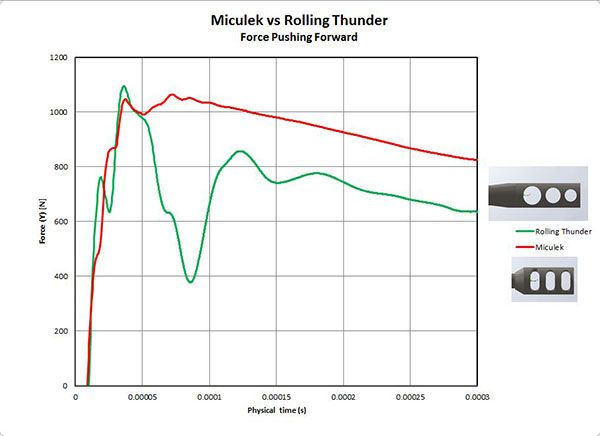
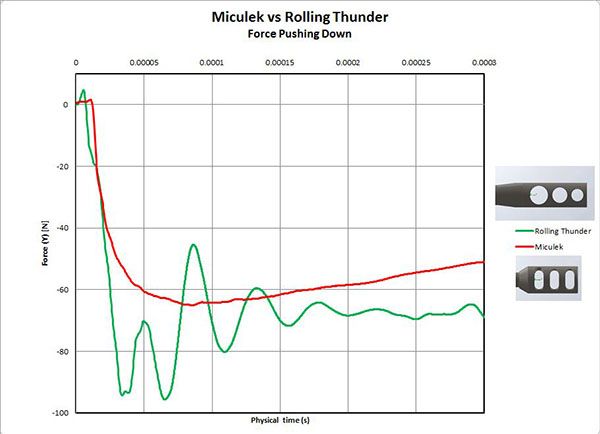
As you can see from the graphs the Miculek comp works better for recoil but the Rolling Thunder has a slight edge on force pushing down. The results are similar to the findings from the compensator comparison article that Patrick Kelley published in Nov/Dec 2009 issue of Front Sight. Recoil reduction: Miculek 65%, Rolling Thunder 57%.
Not really sure why the big guns are using it, maybe the extra weight up front helps out? But I am also guessing that if some of these guys stuck a potato on the end of their rifle they would still win most of the matches.
Link to the Miculek comp simulation video: Miculek comp video
*Note: The forces shown in the Miculek video are a little higher than shown in the comparison graph. The comparison graph results were calculated at a higher resolution and are more accurate.
I also did a sim on a pistol compensator in the Open Pistols forum if anyone is interested. Pistol Comp post
And would someone please tell me how you embed the Youtube player into the posts. I have tried every combination of insert links I can think of.
Thanks.
-
Here is another simulation I did of a very popular rifle compensator. Not quite as interesting as the pistol compensator sim.
-
I use smaller ports in my comps. I have bad elbows and I made a bunch of comps with different size ports, different number of ports, different shaped ports, and it seems, at least for me, that having smaller ports (which results in more vertical surfaces for the gas to push against) feels better on my elbows.
Others have also noticed that my comp doesn't have a lot of flame or gas coming out the top. I figure all that flame and smoke coming out the top (of other comps) is gas/pressure that can't be used to reduce felt recoil. Anyway, the smaller ports seem to work good for me.
I also add an area between the end of the barrel and first port for the gas to expand before it hits the first port. I haven't done any flow model like you but my setup seems to work pretty good. It would be cool to see my design run through your model.
D
[edited for typo]
The real trick to compensator design is with the spacing of the baffles, if it’s too close a lot of gas goes through the hole in the baffle if it’s too far away then the gas expands and misses the baffle surface. There is a sweet spot which balances these two losses.
As you have found out that typically smaller ports closest to the barrel “high pressure port” work better (at least in simulation anyways). As the gas passes through each baffle the pressure drops and the gas expands at a lower angle making the “sweep spot” farther away than the preceding baffle distance.
Looking at the compensators on the market most seem to be designed backwards from this in that they have the largest port first and then the smaller ports.
With muzzle flash that’s a whole other science that’s harder to predict. But my best guess would be the high pressure of the small port allows the gas to expand at a quicker rate cooling it faster before the gas mixes with enough air and a secondary flash can occur.
-
From what's being said here I'm beginning to think the size of the exit holes is not as critical to performance as I once thought... Does anyone have any experience with say .375" holes and .400" holes in the same comp?
Depending on the compensator design the hole size can be important. If you have three of more ports then you can get away with a bigger hole because the next ports will take up the slack. If you are running one or two ports then you will want to make the hole as small as you can get away with especially if the comp is physically small where you don't have much room to let the gas expand much.
Wouldn't fast burning powders and slower burning powders play in there too ? Even different barrel lengths ( government length and shorty , or somewhere in between ) And one of my theory's is the same comp you use for a 38 super or super comp may not be the right choice for a 9 major, even though velocities may be the same but pressures won't. This is good data, but still a lot of variables
What is important is the muzzle pressure at the point the bullet exits the barrel, the higher the pressure the more energy the comp has to work with. Barrel length, powder burn rate, bullet weight... will effect this. That being said changes in pressures will not affect the compensator design very much you may only see about a 5% change in port sizing. The biggest difference is the divergent angle of the gas as it expands, at higher pressures the gas will expand at a greater angle by just a little bit which will affect the spacing of the baffles.
But in general a compensator design to work at high pressures will also work well with lower pressures, I doubt you would notice the difference between a compensator design for higher pressures and one optimized for lower pressure.
The video states a peak muzzle pressure of 6900psi, which I'd be willing to bet is formulated from a slow burning powder like N105 in a 5" barrel, maybe the OP can clue us in, but if the powder were faster or the barrel shorter, that number would go down.
The 6900psi came from my current load of 38 super TJ, 10.6gr of AA -No. 7, 124gr JHP and 5" barrel (pressure data calculated using QuickLoad). Your are correct in that changing to a faster powder with the same power factor would reduce the pressure. But if you reduce the length of the barrel a faster powder may increase the muzzle pressure, a lot of variables to play around with.
-
thats freakin awesome.....Not that I have really searched for it, but this is the first scientific evaluation I have seen. It seems like all other evaluations are purely opinions and feel. Would really be interesting to do a comparison of a few existing designs. Although, it really is subjective since every differently designed gun requires a different effect from the comp to achieve the final desired flat shooting, fast pistol.
That’s the biggest problem with simulation. I can predict fairly accurately how the comp performs, this one makes more down force... this on pushes forward more...this one has a lower force spike. But it won't tell me if it will hold the gun flatter. But simulation does greatly reduce the number of different versions you need to try out since you have knowledge of what the changes will do.
Nice, I just started setting up a SW Flow model about a week ago as well. We should talk about boundary conditions! Did you use a pressure input or a velocity?
That took me about half a year to figure out and get working correctly. You really can't use inlet ports even if you have an accurate pressure or velocity curve to work with. The design of the compensator will affect the flow rate of the gas out the barrel. The solution is actually fairly simple once you work through it. Hint - You need to model the barrel you are testing the comp with.
Does this take into effect the "plugging" action the bullet has as it passes through each baffle? Looking at the initial flow model I don't think it does. That could greatly effect how much gas is pushed out the ports and how much would make it out the muzzle hole.
Unfortunately SoldWorks does not calculate with "adaptive mesh" so I can't simulate the bullet moving through the compensator. I have access to another program "Ansys" that will do it, but it's a huge amount of work to get to run. One of these days I will see if I can get it going to do a comparison.
I have read a bunch of research papers from the US arsenal on muzzle brake theory and calculations, their conclusion was the presence of the bullet will increase peak forces on the baffles but its effect is minimal on the overall performance of the brake.
In the simulations I did the bullet would have left the barrel in around 0.0001 sec. So the bullet would be in the compensator for a little less that 1/4 of the total pressure pulse.
With the bullet you would see larger force spikes in the graph in the beginning but the average forces would not change much. If anything the bullet would increase the effectiveness of the compensator a little bit.
-
So do you have a design on the market or are you going to release one based one some of the data you have?
No, nothing on the market it’s just a hobby for me. I have built a few different ones for my own use so far, a couple of rifle and shotgun comps. I also have some pistol comp designs that I am still playing around with but I don't have any plans to sell them. Seems like everyone and their brother has their own compensator design on the market right now.
-
I have been playing around with compensator designs over the last few years, here are a few simulations I did on one of the available compensators.
I am not going to give an opinion on if I think the design is good or bad, I just thought the videos looked interesting. Plus it gives a look at what is really going on inside the compensator.


Deltapoint part deux!
in Open Pistols
Posted
Does anyone know if the new DeltaPoint2 uses the same mounts/footprint as the original? I am going to machine in a low profile mounting pattern (including pins) into a slide for the original DeltaPoint and would like to know if I should wait and get a DP2 before doing it.